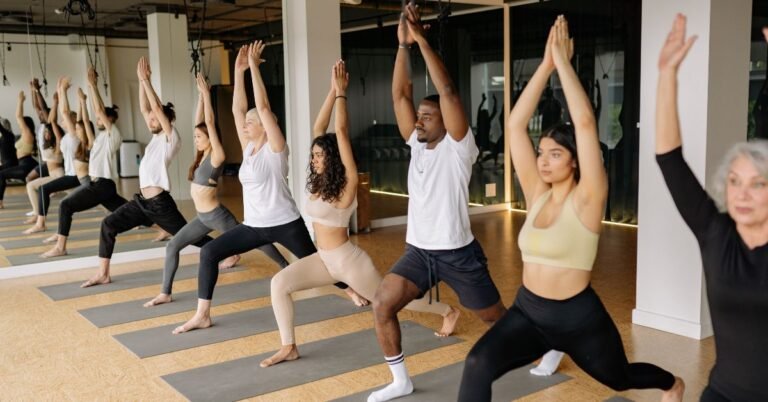In today’s fast-paced world, many of us find ourselves glued to our desks, leading a predominantly sedentary lifestyle. This lack of movement can have detrimental effects on our health, but incorporating yoga into our daily routine offers a powerful remedy. Let’s explore how yoga can counteract the negative impacts of a sedentary lifestyle and guide you towards a healthier, more active life.
Yoga for Sedentary Lifestyle: Understanding the Sedentary Lifestyle
A sedentary lifestyle involves prolonged periods of inactivity, typically characterized by sitting or lying down while engaging in activities like working at a computer, watching television, or reading. This inactivity can lead to various health issues, including obesity, cardiovascular diseases, and musculoskeletal problems.
Yoga for Sedentary Lifestyle: The Impact of Sedentary Habits on Health
Extended sitting can cause muscle stiffness, reduced flexibility, and poor posture. Over time, these issues may escalate into chronic pain, particularly in the back, neck, and shoulders. Additionally, a lack of physical activity is associated with an increased risk of mental health disorders, such as anxiety and depression.
How Yoga Mitigates Sedentary Lifestyle Effects
Yoga offers a holistic approach to counteract the adverse effects of a Yoga for Sedentary Lifestyle. Through a combination of physical postures, breathing exercises, and mindfulness, yoga promotes flexibility, strength, and mental well-being. Regular practice can alleviate muscle tension, improve posture, and enhance overall vitality.
Incorporating Yoga into Your Daily Routine
Integrating yoga into your daily schedule doesn’t require significant time or resources. Simple stretches and poses can be performed at your desk or during short breaks. Establishing a routine, even if it’s just a few minutes each day, can lead to substantial health benefits over time.

Yoga for Sedentary Lifestyle: Essential Yoga Poses for Office Workers
- Seated Forward Bend (Paschimottanasana): This pose stretches the spine and hamstrings, relieving lower back tension.
- Cat-Cow Stretch (Marjaryasana-Bitilasana): A gentle flow between two poses that warms up the spine and eases back discomfort.
- Seated Spinal Twist (Ardha Matsyendrasana): This twist helps maintain spinal flexibility and aids digestion.
- Desk Shoulder Opener: Standing and placing your hands on your desk, step back and lower your chest to stretch the shoulders and chest.
- Wrist and Finger Stretches: To combat the strain from typing, extend your arm forward, gently pull back on your fingers, and hold.
Breathing Techniques to Enhance Energy
Incorporating breathing exercises, or pranayama, can rejuvenate your mind and reduce stress:
- Deep Belly Breathing: Inhale deeply through the nose, allowing your abdomen to expand, then exhale slowly.
- Alternate Nostril Breathing (Nadi Shodhana): This technique balances the nervous system and promotes mental clarity.
Mindfulness and Meditation Practices
Mindfulness involves being fully present in the moment. Incorporating short meditation sessions into your day can reduce stress and improve focus. Even a five-minute meditation can reset your mind and enhance productivity.
Creating a Yoga-Friendly Workspace
Transform your workspace to encourage movement and stretching:
- Ergonomic Chair: Supports proper posture and reduces back strain.
- Standing Desk: Allows alternating between sitting and standing.
- Keep a Yoga Mat Nearby: Encourages spontaneous stretching or brief yoga sessions.
Yoga for Sedentary Lifestyle: Establishing a Consistent Yoga Practice
Consistency is key to reaping the benefits of yoga. Schedule specific times for practice, whether it’s a morning routine to start your day or evening stretches to unwind. Setting reminders can help maintain regularity.
Combining Yoga with Other Physical Activities
While yoga offers numerous benefits, combining it with other forms of exercise, such as walking, cycling, or swimming, can enhance overall health and counteract the effects of prolonged sitting.
Nutrition Tips to Complement Your Yoga Routine
A balanced diet supports your yoga practice and overall well-being:
- Stay Hydrated: Drink plenty of water throughout the day.
- Balanced Meals: Incorporate a variety of fruits, vegetables, lean proteins, and whole grains.
- Mindful Eating: Pay attention to your body’s hunger and fullness cues.
Tracking Progress and Staying Motivated
Keep a journal to note your yoga sessions, how you feel before and after, and any physical or mental changes you observe. Celebrating small milestones can boost motivation and commitment.
Joining a Yoga Community for Support
Engaging with a community, whether in-person or online, provides support and accountability. Consider joining a local yoga class or an online group to share experiences and gain encouragement.
Overcoming Common Challenges in Yoga Practice
It’s normal to face obstacles such as time constraints or physical limitations. Remember, yoga is a personal journey. Modify poses as needed, and prioritize consistency over perfection.
Embracing yoga can significantly counteract the negative effects of a sedentary lifestyle. By incorporating mindful movement into your daily routine, you can enhance both your physical health and mental well-being. Start today, and take the first step towards a more active and fulfilling life.
Can I practice yoga at my desk?
Absolutely! Many yoga stretches can be performed while seated or standing at your desk, making it convenient to integrate into your workday.
How often should I do yoga to see benefits?
Even practicing for a few minutes daily can yield positive results. Consistency is more important than duration.
Do I need any special equipment for office yoga?
No special equipment is necessary. A comfortable chair and a little space are sufficient to perform basic stretches and poses.
Can yoga help with back pain caused by prolonged sitting?
Yes, specific yoga poses target back muscles and can alleviate pain associated with extended periods of sitting.
Is it necessary to join a yoga class, or can I practice on my own?
While classes offer guidance and community, many resources are available for self-practice. Choose what best fits your schedule and comfort level.
Read More: Hatha Yoga Classes; The Best Time to Eat Dinner, According to Experts
Read More: Top 12 Standing Yoga Asanas to Improve Posture and Stability
Our Services: Hatha Yoga Classes | Ashtanga Yoga Classes | Kids Yoga Classes | Pranayama Classes | Therapeutic Yoga for Thyroid Workshop | Therapeutic Yoga for PCOD/PCOS Workshop | Therapeutic Yoga for Diabetes Workshop | PostNatal Yoga | PreNatal Yoga
Other Calculator: Bmr Calculator | Gst Calculator | Date Of Birth Calculator | Calorie Calculator | Loan Calculator | Home Loan Calculator | Sukanya Samriddhi Yojana Calculator | Mileage Calculator | Interest Calculator | Compound Interest Calculator | Cumulative Interest Calculator | Rd Calculator | Days Calculator | Income Tax Calculator | Fd Calculator | Swp Calculator | Personal Loan Calculator | Mutual Fund Calculator | Square Root Calculator | Irr Calculator | Future Value Calculator | Currency Calculator | Margin Calculator | Bmi Calculator | Date Calculator | Age Calculator | Salary Calculator | Calculator Online | Body Type Calculator | Fraction Calculator | Percentage Calculator | Time Calculator | Bmi Index Calculator | Body Shape Calculator | Free Calculator | Indian Salary Calculator | Fraction Calculator | Body Type Calculator | Date to Date Calculator | Percentage Calculator | Car Loan EMI Calculator | Time Calculator | Age Calculator | BMI Calculator | Bmr Calculator | Calorie Calculator | Bmi Calculator | Body Type Calculator | Bmi Index Calculator | Body Shape Calculator . Also Buy: Hanuman Ji Parvat Image | Hanuman Parvat Image | Janam Patrika Format Pdf | Switch Words For Success | Horse Frame Direction | Elephant Photo Frame | Elephant Photo Vastu | Sheaxis | Himalayan Healings | Yogic Warrior | Ayurvedic Homeopathic | Free Calculator | The Calculator Site | Calculator Online | Travel Story | Kundli Print | Printed Kundli | Vastu Photo Frame | Tarot Card Reading | Glycemic Index Calculator | surya namaskar 12 steps | Aerial Yoga at Home | Hatha Yoga Poses






